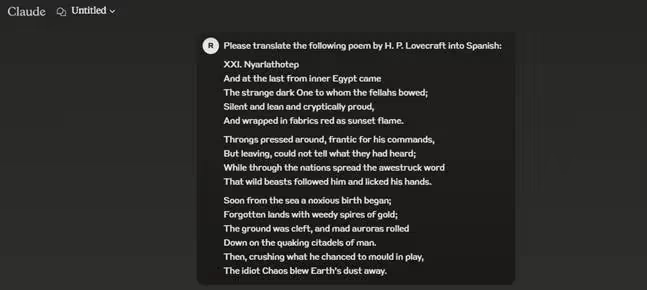Poetry is delicate. It’s not just written—it’s felt, lived. It is, in many instances, a work of art.
A poem captures something raw and untamed, like catching light in your hands.
When you read a good one, it leaves an imprint, like a memory you didn’t know you had.
Translation is the act of carrying that memory across a river without letting it slip through your fingers.
And that’s where the question arises: can artificial intelligence, with all its processing power and precision, do something so tender, so deeply human?
The answer? Not really. But it’s worth exploring what it can do—and what it can’t.

Where AI Helps
AI is good at patterns. It sees structure where humans sometimes see chaos. Give it a simple poem with clear rules—rhyme, rhythm, meter—and it can recreate the bones of it in another language.
Imagine a haiku: short, precise, balanced. AI can handle that. It processes the words, finds the equivalents, and lays them out in a way that works.
In practical terms, AI offers:
- Speed: It drafts translations in seconds.
- Consistency: No stray typos, no missed beats.
- Technical accuracy: Rhyme and rhythm are preserved—when they’re straightforward.
For poems that live in the structure more than the meaning, AI can give you a decent first step. But poetry rarely lives only in its structure.
Where AI Stumbles
Poetry isn’t math. It doesn’t follow formulas or obey rules. It’s messy, emotional, and layered, and that’s where AI falters.
A machine can analyze words, but it doesn’t feel them.
It doesn’t know the sharp ache of longing or the quiet joy of watching sunlight spill through leaves.
It can mimic the shape of a poem, but the heart of it? That’s something else entirely.
Here’s where AI struggles:
- Metaphors: A phrase like “the ocean sang” isn’t about sound; it’s about vastness, loneliness, or comfort. AI doesn’t know how to read between those lines.
- Emotion: Poetry is about making people feel. Machines don’t feel, so they can’t pass that on.
- Culture: Poems often carry the weight of their time and place. AI can’t fully grasp the historical or cultural resonance behind a line.
It’s like listening to a song without the melody. The words might be there, but the music—the thing that makes it linger—is gone.

Why Human Translators Matter
Translating poetry is an act of empathy.
A translator has to step into the poet’s mind, feel what they felt, and then find a way to bring that to life in another language.
It’s not about finding perfect equivalents—it’s about finding echoes, carrying the essence of the poem across without letting it lose its soul.
AI can offer the framework, but it’s the human touch that turns it into something alive.
A New Kind of Collaboration
Here’s the truth: AI doesn’t have to do it all. It’s not here to replace poets or translators—it’s here to help.
Used well, AI can handle the repetitive, technical side of translation, giving human translators the freedom to focus on the art.
Imagine this: AI drafts a translation, catching the rhyme and rhythm, and then you, the translator, take over.
You reshape it, layer in the emotion, and choose the words that make the poem sing.
Together, you create something that neither could do alone.

The Soul of Poetry
Poetry is, and always will be, human.
It’s a conversation between the poet and the reader, a bridge built out of words and feelings.
AI can’t create that—it doesn’t dream, love, or grieve.
And that’s okay. Machines don’t need to feel poetry.
That’s our gift, our privilege. AI’s role is to support us, to give us tools that make our work easier, faster, and perhaps a little more inspired.
Because in the end, the soul of poetry belongs to us—and it always will.
Research
As a professional translator, literature buff, and published amateur author-poet in Spanish and English, exploring the possibilities of translating poetry with an LLM is quite a titillating endeavor.
Below you’ll be able to read about a few findings I came across while conducting this experiment.
Certainly, both humanity and AI models are and will always remain works in progress, so what we find today “hard to achieve”, could well become feasible in a couple of days, weeks, or months.
The poem we will translate is “XXI. Nyarlathotep” by H. P. Lovecraft.


The GPT4 translation leaves the Arabian word “fellahs” directly in the source language, instead of translating it into Spanish (this is both mistranslation and omission, and quite a mistake in the culture realm). It shows zero research and insight.
The “Being” in question is well translated to “Ser” in uppercase because it implies that it is majestic and powerful.
This is a nice surprise since the model noticed the relevance of this term.
The use of uppercase at the beginning of verses is not the norm in Spanish, and it should be avoided.
It is carbon copied from English (lack of reasoning).
When writing poetry, authors use language in an unusual way in order to create beauty and express emotion, while engaging the reader (hopefully).
Literal translations in poetry eliminate this core mission of poetry and thus, do not “fly”.
Besides, literality rips the charm away from the original metaphors and leaves the poem a blunt tool.
In English, when we say “spread the word”, this does not literally mean “murmullo or palabra”. It is a set expression that translates more naturally into Spanish as “se corrió la voz.”
Therefore, this is a mistranslation by the LLM (misuse of a figure of speech).
The last verse includes a mistranslation because to “blow away” means to blow and scatter something.
And this version only translates this partially (lack of reasoning).
GPT-04 missed the challenge of using different translations for “lands”, “ground”, and “Earth”. It repeated “tierra” in all cases, but it could have been avoided, because repetition was not intended as a literary resource, in this case.
Unnecessary literal translations were highlighted (lack of synonyms research, lack of reasoning).


Correct use of lowercase at the beginning of each verse, correct uppercase in “Uno”, same mistake as GPT-04 with the word “fellahs”.
This version includes, as well, several literal translations which show the lack of attention to deep-rooted details in how the author wanted to express himself.
In English, when we say “spread the word”, this does not literally mean “palabra”. It is a set expression that translates more naturally into Spanish as “se corrió la voz.” Therefore, this is a mistranslation by the LLM (misuse of a figure of speech).
Unnecessary literal translations were highlighted (lack of synonyms research, lack of reasoning).


This entire translation is painfully literal, and the most literal of all three models.
To add to literality on the wrong side, it includes a typo in Spanish in the word “crípticament” that is missing the “e”.
Unnecessary literal translations are highlighted (lack of synonyms research, lack of reasoning).
Furthermore, this version does not respect the use of lower and uppercase in Spanish in any of the verses.
All languages are rich. We can agree on that.
But Spanish is especially rich in synonyms that translators can use to raise the poem’s translation to, at least, the same level as the original.
Literal translation manages to kill all the emotions the author exuded in her/his work.
This is regardless of their nature: dark, bottomless, romantic, whatever they are.
This desensitization of poetry generates a written text that feels like robot-like instructions to kiss someone you passionately love. Pointless.
XXI. Nyarlathotep By RC

This is my version for your reference. I tried to keep a balance between adaptation, creative recreation, and literal translation when needed, respecting metaphors, imagery, and deep meaning.
In my translation, I tried to look for synonyms in order not to repeat “tierra” 3 times.
Sometimes in poetry repetition is an aesthetical resource. I made a decision not to repeat it, because in Spanish it would become monotonous.
From the above, we conclude that AI tools are technically able to translate poetry, but they do so with profound shortcomings that need human work to be corrected.
There are, undoubtedly, other fields of writing in which LLM can provide a much brighter and more useful performance. At least for the time being.
Unlock the power of glocalization with our Translation Management System.
Unlock the power of
with our Translation Management System.


























